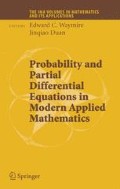Abstract
For a class of Markov chains that arise in ecology and economics conditions are provided for the existence, uniqueness (and convergence to) of stationary probability distributions. Their Feller property and Harris irreducibility are also explored.
Supported in part by Grant AFOSR IISI F49620-01-1-0076. This paper is based on the talk presented by the author at the IMA conference on Probability and P.D.E.
Access this chapter
Tax calculation will be finalised at checkout
Purchases are for personal use only
Preview
Unable to display preview. Download preview PDF.
References
ATHREYA K.B. (1996). The vacillating mathematician, Resonance. J. Science and Education, Indian Academy of Sciences, Vol. 1, No. 1.
ATHREYA KB. (2003). Harris irreducibility of iterates of i.i.d. random maps on R +. Tech. Report, School of ORIE, Cornell University.
ATHREYA K.B. (2004a). Stationary measures for some Markov chain models in ecology and economics. Economic Theory, 23: 107–122.
ATHREYA K.B. (2004b). Markov chains on Polish spaces via i.i.d. random maps. Tech. Report, School of ORIE, Cornell University.
ATHREYA K.B. AND DAI J.J. (2000). Random logistic maps I. J. Th. Probability, 13(2): 595–608.
ATHREYA K.B. AND DAI J.J. (2002). On the nonuniqueness of the invariant probability for i.i.d. random logistic maps. Ann. Prob., 30: 437–442.
ATHREYA K.B. AND NEY P. (1978). A new approach to the limit theory of recurrent Markov chain. Trans. Am. Math. Soc., 245: 493–501.
ATHREYA K.B. AND SCHUH H.J. (2003). Random logistic maps II, the critical case. J. Th. Prob., 16(4): 813–830.
ATHREYA KB. AND STENFLO O. (2000). Perfect sampling for Doeblin chains. Tech. Report, School of ORIE, Cornell University. (To appear in Sankhya, 2004).
BHATTACHARYA R.N. AND Rao B.V. (1993). Random iteration of two quadratic maps. In Stochastic processes: A. Fetschrift in honor of G. Kallianpur, pp. 13–21, Springer.
BHATTACHARYA R.N. AND MAJUMDAR M. (2004). Random dynamical systems: A review. Economic Theory, 23(1): 13–38.
BHATTACHARYA R.N. AND WAYMIRE E.C. (1999). An approach to the existence of unique invariant probabilities for Markov processes, colloqium for limit theorems in probability and statistics. J. Bolyai Soc. Budapest.
BARNSLEY M.F. (1993). Fractals everywhere. Second edition, Academic Press, New York.
CARLSSON N. (2004). Applications of a generalized metric in the analysis of iterated random funct ions. Economic Theory, 23(1): 73–84. (1980). Iterated random maps on the interval as
DEVANEY R.L. (1989). An introduction to chaotic dynamical systems. 2nd edition, Academic Press, New York.
DE MELO W. AND VAN STRIEN S. (1993). One dimensional dynamics. Springer.
DIACONIS P. AND FREEDMAN D.A. (1999). Iterated random function. SIAM Review, 41: 45–76.
GUCKENHEIMER J. (1987). Limit sets of S-unimodal maps with zero entropy. Comm. Math. Physics, 110: 655–659.
HASSEL M.P. (1974). Density dependence in single species populations. J. Animal Ecology, 44: 283–296.
KIFER Y. (1986). Ergodic theory of random transformations. Brikhauser, Boston.
MAY R.M. (1976). Simple mathematical models with very complicated dynamics. Nature, 261: 459–467.
MEYN S. AND TWEEDIE R.L. (1993). Markov chains and stochastic stability, Springer.
NUMMELIN E. (1984). General irreducible Markov chains and nonegative operators. Cambridge University Press.
RICKER W.E. (1954). Stock and recruitment. Journal of Fisheries Research Board of Canada, II:559–623.
VELLEKOVP M.H. AND HOGNAS G. (1997). Stability of stochastic population model. Studia Scientiarum Hungarica, 13: 459–476.
WEI BIAO Wu (2002). Iterated random functions: Stationary and central limit theorems. Tech. Report, Dept. of Statistics, University of Chicago.
Author information
Authors and Affiliations
Editor information
Editors and Affiliations
Rights and permissions
Copyright information
© 2005 Springer Science+Business Media, Inc.
About this chapter
Cite this chapter
Athreya, K.S. (2005). Nonnegative Markov Chains with Applications. In: Waymire, E.C., Duan, J. (eds) Probability and Partial Differential Equations in Modern Applied Mathematics. The IMA Volumes in Mathematics and its Applications, vol 140. Springer, New York, NY. https://doi.org/10.1007/978-0-387-29371-4_1
Download citation
DOI: https://doi.org/10.1007/978-0-387-29371-4_1
Published:
Publisher Name: Springer, New York, NY
Print ISBN: 978-0-387-25879-9
Online ISBN: 978-0-387-29371-4
eBook Packages: Mathematics and StatisticsMathematics and Statistics (R0)

